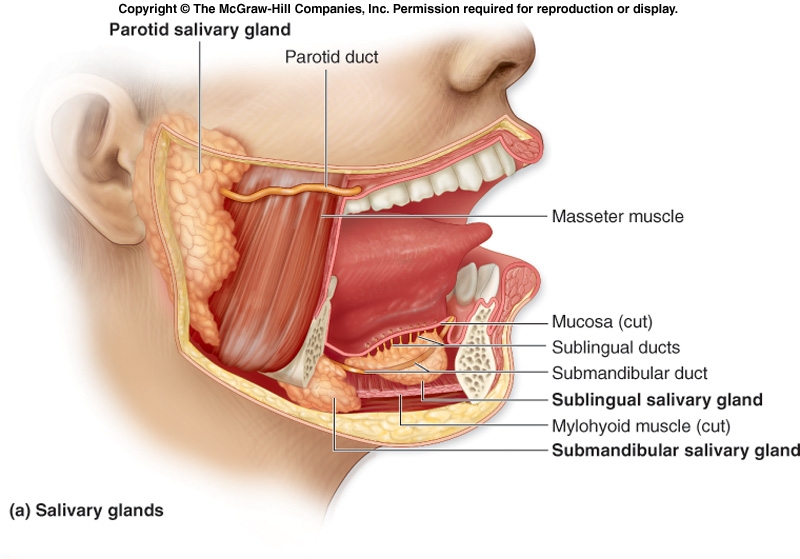Structure/Function:
Mouth
The mouth is a hollow chamber with a roof, a floor, and walls. It is lined with mucus membrane. The roof of the mouth consists of the hard and soft palates. The hard palate is bony and is in the front portion of the mouth and is formed by the palatine and maxillary bones. The soft palate is located above the posterior portion of the mouth—it is soft because it is made of mostly muscle. Hanging from the center of the soft palate is the uvula that is cone-shaped. The uvula and soft palate prevent food and liquid from entering the naval cavity, which is above the mouth. The floor of the mouth is made of the tongue and it’s muscles.
Tongue
The tongue is made of skeletal muscle covered with mucus membrane. It is anchored to bones in the skull and the hyoid bone in the neck. A thin membrane the “frenulum” attached the tongue to the floor of the mouth. On the surface of the tongue are many small elevations or “papillae”. Tastebuds which are made up of sensory receptors are located on the papillae.
Teeth
The four major types of teeth are: incisors, canines, pre-molars, and molars. Incisors have a sharp cutting edge and are for during mastication (or chewing) of food. Teeth are often referred to as cusped and are for tearing food that is being eaten. Pre-molars are often referred to bicuspids and molars, tricuspids. Molars have large flat surfaces with two or three grinding cusps on their surfaces. Teeth are needed for extensive breakdown of food in the mouth. Food is then molded into a small round mass called a bolus. There are three parts of a tooth: the crown, the neck, and the root. The crown is the part that is visible in the mouth which is covered by the enamel which is the hardest tissue in the body. Enamel is ideal because it withstands grinding during eating. The outer shell of each tooth is convered by two other tissues: dentine and cementum. Dentine makes up the greatest portion of the tooth shell and is covered by enamel in the crown. Cementum is in the neck and root areas. The center of the tooth has a pulp cavity that has connective tissue, blood, lymphatic muscles, and sensory nerves. The neck is the narrow portion surrounded by gum tissue which joins the crown to the root. Periodontal membrane lines each tooth socket.

http://weblogs.newsday.com/sports/watchdog/blog/mouth-diseases.jpg
Salivary Glands
There are three kinds of salivary glands: the parotids, submandibulars, sublinguals. The glands on average secrete most of about one liter of saliva per day. They are located outside the digestive tube and must convey their secretions from ducts into the tract. The parotid glands are the largest and they lie just below and in front of each ear at the angle of the jaw. The duct of the submandigular open into the mouth on either side of the lingualfrenulum and open into the floor of the mouth.
Mucus
Saliva contains mucus and a digestive enzyme called salivary amylase Mucus moistness food and helps it pas with less friction through the digestive process. Salivary amylase begins the breakdown of carbohydrates.

http://academic.kellogg.cc.mi.us/herbrandsonc/bio201_McKinley/f26-4a_salivary_glands_c.jpg
Chemical Action:
Most digestion of fats and carbohydrates occurs after the food reaches the small intestine—mostly because the amylase doesn’t have time to break it down because we swallow too fast. Also, protein digestion in the stomach. The salivary amylase that makes up saliva digests/hydrolyzes starches and results in maltose.
Comments (0)
You don't have permission to comment on this page.